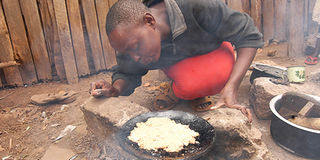It’s a pig’s life for starving Kenyans

Ann Wangeci of Muringato slum in Nyeri Central district prepares 'chapati' made from the Pollard pig feed for her family on August 16, 2009. The locals have been making 'chapatis' with the pig feed due to the high cost of maize and wheat flour as drought continues. Photo/ JOSEPH KANYI
What you need to know:
- Animal feed three times cheaper than maize in slums without relief food
Poor residents in Nyeri slums, Kenya, are turning to pig food as hunger bites and food prices get out of reach.
Pollard — the brand name for animal feed normally fed to cattle and pigs — is easily available in shops for Sh1,200 per 90-kilogramme bag, compared to Sh3,000 for maize and Sh4,000 for wheat flour.
Now the animal feed has become a staple food in Nyeri’s poverty ravaged slum villages of Muringato, Chania, Mathari and Githuri, where relief food is rare.
“The last time they brought relief food here was a month ago. I got three tins of maize and two of beans. They ran out within a week,” said 65-year-old Ziporah Wangari.
The slum dwellers say, that unlike the relief food that runs out quickly, the animal feed comes in larger quantities, and at a cheaper price.
“One sack of Pollard feeds six families for more than a week,” says 35-year-old single mother, Jane Wanjiru. She does odd jobs in town to feed her four children.
“We contribute Sh200 each. Then we send someone to the animal feed shop,” confessed Jane.
At the animal feed shop, no questions are asked. The shop owner, they say, has no idea that the pig food he sells actually goes to feed human beings.
The women then divide the Pollard equally among the contributors. Then the delicate process of baking “chapati” begins.
“It is not easy to make dough from the Pollard, but we try,” said Mama Muthoni.
The mother of two took the Nation through the delicate process. “First, you need a little wheat flour, at least a spoonful per chapati, it helps keep the dough together,” she explains.
The few who can afford an entire packet of wheat flour mix it with several tins of pollard. The family is guaranteed at least a week’s supply. Those that cannot afford the sprinkle of ordinary wheat flour simply roast paste on hot baking pans.
“They are not as easy to bake alone, but we try,” explains Ms Ann Wangeci, a single mother four.
The biggest challenge comes in ensuring that the mixture does not disintegrate in the baking pan. The women spread the dough on an oiled hot baking pan. The result is something between a chapati and crumbling brown biscuit. This they serve with black tea, or just plain.
But this dish, they say, comes at a price — their children have complained of stomachache and diarrhoea. “The children complain, but what are we to do? At least they eat,” says Ms Wangeci.
A number say the animal feed gives them bloated tummies all day long. But this, they say, was what they meant it to do in the first place — fill their stomachs.
Mr Mathew Mbake, a nutritionist based in Isiolo, said: “The digestive system of human beings is not similar to that of animals. Normally pollard is adapted for the digestive systems of cattle and pigs.
“It’s true, the animal feed is not very different from human feed; humans too belong to the animal kingdom, but my only fear is that Pollard may contain chemical harmful to human beings,” he said.
But desperate slum dwellers seem to have thrown caution to the wind. Unless adequate food rations reach them, pig feed will continue to be served for dinner.
“I will give them the Pollard, what else can I give them?” asked 35-year-old father of three, John Mwangi.
They were full of praise for the Kazi Kwa Vijana initiative. For long since its inception, they said, it enabled them get the cash to buy the Pollard. For the last week though, the project has disappeared. “We hope it’s not gone forever. We need jobs more than relief food,” said Mr Mwangi.
But not everyone is strong enough to work, like 65-year-old Zipporah Wangari, who lives with two orphaned grandsons in a wooden shanty. The sickly widow does not have the energy to jostle for relief food, leave alone contribute to the Pollard buying project.
“They share some of the Pollard with me. We eat when we get some, when we don’t, we stay without food,” she told the Nation.




